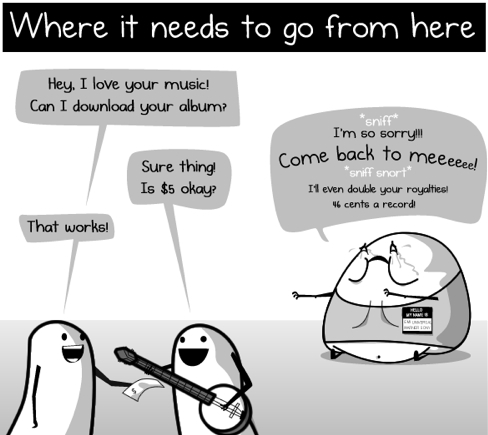I am a bit surprised that there was not more buzz around Doc Searls’ recent article, The Customer is God, where he re-hashed his argument for a new world of merchant/customer relationship that he has been noodling on for the past several years.
Since the Industrial Revolution, the only way a company could scale up in productivity and profit was by treating customers as populations rather than as individuals—and by treating employees as positions on an organization chart rather than as unique sources of talent and ideas. Anything that stood in the way of larger scale tended to be dismissed.
The Internet has challenged that system by giving individuals the same power. Any of us can now communicate with anybody else, anywhere in the world, at costs close to zero. We can set up our own websites. We can produce, publish, syndicate and do other influential things, with global reach. Each of us can be valuable as unique individuals and not only as members of groups.
The internet has enabled intimacy at scale. It is now possible for each of us to reach out to almost anyone, anywhere in the world and have a direct conversation. Doc argued in his seminal book, The Cluetrain Manifesto, the internet is the great dis-intermediator. We have seen it route around the middleman in every industry it has touched.
Today, consumers are moving away from commercial enterprises to tell them what to buy. They are increasingly turning towards their social networks for recommendations. Instead of a visit to a cookie-cutter mall, consumers are turning to more personal forms of curation which gives rise to sites such as Yelp, Etsy, or Pinterest.
The next phase in the evolution of consumer behavior which Doc has been banging on about is the era of the Vender Relationship Management (VRM). In this world, the consumer will maintain a profile of items which they are open to purchase. In much the same way we maintain a Facebook or LinkedIn profile as our signpost of our interests and desires, the VRM profile will be a strictly commercial profile, a public wishlist outlining items we hope to purchase complete with details of price and delivery options. Like the old mailbox flag that you would flip up on the country road to signal to the mailman that you have a letter for them to pick up, you would manage your VRM profile as a way to signal what type of offers they are open to evaluating and giving your attention.
Flipping the advertisement model on its head, the VRM arrangement channels only those advertisements that are guaranteed to be relavent to you and puts the power of control back into your hands. In this world there is no need to be tracked because you explicitly tell the ad networks exactly what you want. No more wasted impressions competing for your attention. In this world, advertising evolves from marketing to a sales channel.
The move from a “stalking economy” where vendors are always following you around trying to figure out what you want to a world where we clearly state what we want is already happening. Kickstarter is an example of this new “intention economy” where people directly signal what they want by actually pledging money towards products they’d like to see built.
Keep an eye out for companies and technologies that enable this direct consumer intent. These will be the ones that are on the right side of the wave. These will be the ones that succeed.



Leave a comment